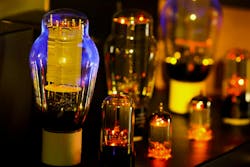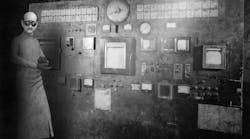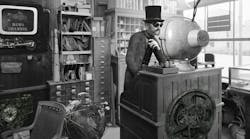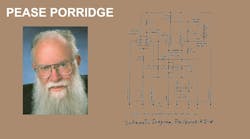Vacuum tube amplifiers just won’t go away. I am speaking more of audio vacuum tube amps than I am of microwave amps like magnetrons, klystrons, TWTs and the like. Most other audio gear is solid state so why are there still vacuum tube amps? My grandson asked me that recently and it was hard to explain this phenomenon. What I basically said is that vacuum tubes amps sound better than solid state amps, to some people. I had no way to follow up or demo this effect.
I have actually compared solid state audio power amps to the vacuum tube equivalents several times and using the same speakers. (It seems to me that the speakers would have more of an effect on the sound than the type of amplifier.) I could discern a difference between the two. I do not have the words to describe the difference. It is akin to comparing wines in a tasting. There are words for that but they are also vague and subjective to be sure. So it is with audio sounds. I have actually heard people say they can tell the difference between two different sets of speaker cables and connectors. I still don’t believe it.
So are vacuum tubes amps better? I’m not sure. They do still sound very good and for me it also depends on the music being played. Guitar players almost universally favor vacuum tube amplifiers. There are certainly enough vacuum tube audio power amp manufacturers to support the niche. I ran across one called Frenzel Tube Amps in Texas. No relation to me. These guys build custom amps for audio systems and musicians. And there are a dozen or so other tube amp companies. Amazing.
Not only that, I recently discovered a new book Building Valve Amplifiers, 2nd edition by Morgan Jones. It is a highly detailed book on the actual design and construction of tube amplifiers. Published by Newnes/Elsevier, the book covers planning, metalworking, wiring and testing. A real nitty gritty book for hobbyists and serious manufacturers. For example, the book details things like how to orient audio and power transformers to avoid problems of magnetic flux leakage from affecting other transformers or the tubes themselves. The test section is excellent. You may even learn where to find a loctal socket for a 7N7.
Incidentally the book is a companion to the book Valve Amplifiers, 4th edition also by Morgan Jones and published by Newnes/Elsevier. This is a serious design book with details on audio circuit design, equations and related topics. A 4th edition means that the book has been around for a while and is being updated and there is a real market for it.
Anyway, I no long have any tubes or tube equipment around. Very early in my career I worked as an engineer in industrial electronics and I recall that I could make almost anything I needed with a 12AU7, 12AX7 and/or a relay. The early germanium PNP 2N1305s did not cut it. Those days are gone for good. And even my ham gear is solid state although one can still buy RF power amps with multiple kinds of vacuum tubes. It is hard to beat them for power RF in the HF range. LDMOS amps are available too but more expensive. And I suspect we will see some GaN ham power amps at modest prices in the near future. But I am not betting on the demise of the vacuum tube.
About the Author

Lou Frenzel Blog
Communications Technology
Click here to find more of Lou's articles on Electronic Design.




